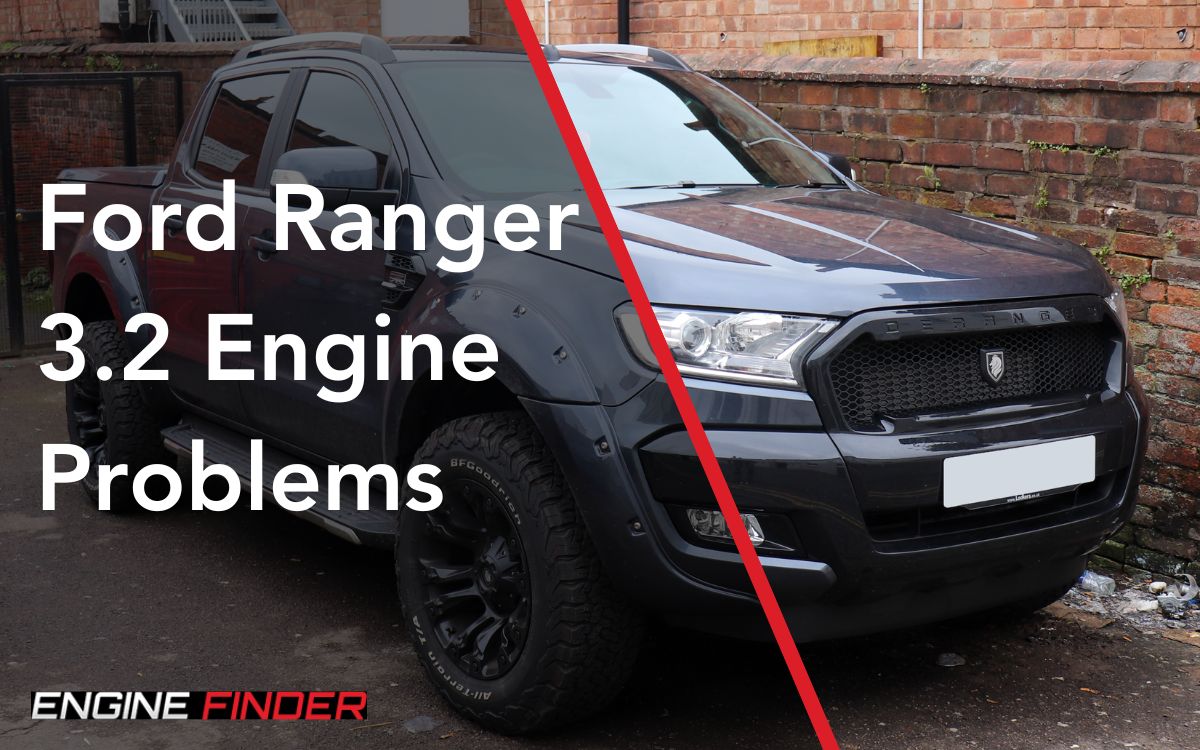
Ford Ranger 3.2 Engine Problems: EGR Cooler and Turbocharger Issues
Key Takeaways
| Problem | Main Symptoms | Possible Causes |
|---|---|---|
| EGR Cooler Failure | Coolant loss, overheating, white smoke | Cracked cooler, corrosion, poor coolant quality |
| Turbocharger Problems | Loss of power, excessive smoke, oil leaks | Oil starvation, foreign object damage, bearing failure |
| Oil Pump Malfunction | Low oil pressure, engine knock | Variable pump failure, air in system, priming issues |
| Piston Damage | Sudden power loss, white smoke, no restart | Overheating, high EGT, poor maintenance |
| Cooling System Issues | High temperatures, steam, coolant loss | Thermostat failure, head gasket issues, radiator blockage |
The Ford Ranger 3.2 is equipped with a 3.2-liter five-cylinder turbocharged diesel engine (P5AT) that has powered the popular PX-series Rangers from 2011 to 2019. Also used in the Mazda BT-50, this engine is known for its robust performance and towing capability. However, several recurring issues have emerged over the years that owners should be aware of, particularly as these vehicles accumulate mileage and age.
Ford Ranger 3.2 Engine Specifications
| Specification | Details |
|---|---|
| Engine Code | P5AT (Duratorq TDCi) |
| Displacement | 3.2L (3,198cc) |
| Configuration | Inline-5, DOHC |
| Fuel System | Common Rail Direct Injection |
| Turbocharging | Single variable geometry turbocharger |
| Power Output | 147 kW (200 hp) @ 3,000 rpm |
| Torque | 470 Nm @ 1,750-2,500 rpm |
| Compression Ratio | 16.2:1 |
| Production Years | 2011-2019 |
1. EGR Cooler Failure
Causes
- Corrosion and cracking of the EGR cooler internals
- Poor coolant quality and infrequent changes
- Temperature cycling stress on cooler components
- Manufacturing defects in early production models
- Contamination from diesel particulate filter (DPF) issues
Symptoms
- Rapid coolant loss without visible external leaks
- White smoke from exhaust, especially on startup
- Engine overheating under load
- Coolant contamination in intake system
- Check engine light activation
Solution
- Replace EGR cooler with updated part number
- Flush cooling system completely
- Replace coolant with OEM-specification fluid
- Clean intake system of coolant contamination
- Update ECU software if available
DIY Difficulty / Hours
- EGR cooler replacement: Very Difficult / 6-8 hours
- Professional repair recommended due to complexity
- Cost: R8,500-R15,000 including parts and labor
EGR Cooler Recall
Ford issued recalls for EGR cooler failures on certain production dates. Check if your vehicle is affected by the recall before paying for repairs, as warranty coverage may apply.
2. Turbocharger Problems
Causes
- Oil starvation due to delayed oil changes
- Foreign object damage through air intake
- Turbocharger bearing wear from high mileage
- Excessive exhaust gas temperatures (EGT)
- Contamination from DPF regeneration cycles
Symptoms
- Significant loss of power and acceleration
- Black or blue smoke from exhaust
- Whistling or grinding noises from engine bay
- Oil leaks around turbocharger
- Increased fuel consumption
Solution
- Replace turbocharger assembly with quality unit
- Install new oil feed and drain lines
- Replace air filter and check intake system
- Perform oil and filter change
- Inspect exhaust system for restrictions
DIY Difficulty / Hours
- Turbocharger replacement: Difficult / 5-7 hours
- Requires specialized tools and knowledge
- Cost: R15,000-R25,000 including installation
Turbo Longevity Tips
Allow the engine to idle for 30-60 seconds before shutting down after highway driving to prevent oil coking in the turbocharger bearings.
3. Oil Pump Malfunction
Causes
- Variable displacement oil pump failing to prime
- Air ingestion during oil changes
- Low oil levels causing pump cavitation
- Oil pump drive chain stretch or failure
- Contaminated oil affecting pump operation
Symptoms
- Low oil pressure warning light
- Engine knock or bearing noise
- Metal particles in oil
- Difficulty starting after oil changes
- Reduced engine performance
Solution
- Replace oil pump and drive components
- Ensure proper oil filling and priming procedures
- Use correct oil viscosity (5W-30 synthetic)
- Replace oil pressure sensor if faulty
- Perform compression test to check for damage
DIY Difficulty / Hours
- Oil pump replacement: Very Difficult / 8-12 hours
- Requires engine removal or significant disassembly
- Cost: R12,000-R20,000 including labor
Critical Oil Pressure
If oil pressure drops suddenly, stop driving immediately. Continued operation can cause catastrophic engine damage within minutes.
4. Piston Damage
Causes
- Excessive exhaust gas temperatures from overloading
- Detonation from poor fuel quality or timing issues
- Overheating episodes causing thermal stress
- Carbon buildup affecting combustion
- Manufacturing defects in piston materials
Symptoms
- Sudden and complete loss of power
- Dense white smoke from exhaust
- Engine will not restart after failure
- Coolant mixing with oil (milky appearance)
- Metal debris in oil
Solution
- Complete engine rebuild or replacement
- Machine cylinder head if salvageable
- Replace all pistons, rings, and bearings
- Address root cause of overheating
- Update to latest piston part numbers
DIY Difficulty / Hours
- Engine rebuild: Expert level / 20-30 hours
- Professional rebuild strongly recommended
- Cost: R35,000-R65,000 depending on damage extent
Prevention is Key
Avoid extended high-load operation, maintain proper servicing, and monitor exhaust gas temperatures to prevent piston damage.
5. Cooling System Issues
Causes
- Thermostat failure leading to overheating
- Radiator blockage from debris or corrosion
- Water pump bearing failure or impeller damage
- Head gasket deterioration from overheating
- Cooling fan malfunction or relay failure
Symptoms
- Engine temperature gauge reading high
- Steam or vapor from engine bay
- Coolant puddles under vehicle
- Poor cabin heating performance
- Gurgling sounds from cooling system
Solution
- Replace thermostat and housing assembly
- Flush radiator and cooling system
- Test and replace water pump if necessary
- Pressure test for head gasket integrity
- Repair or replace cooling fans
DIY Difficulty / Hours
- Thermostat replacement: Moderate / 2-3 hours
- Water pump replacement: Difficult / 4-6 hours
- Radiator service: Easy / 1-2 hours
- Cost: R800-R6,500 depending on components
Cooling System Maintenance
Replace coolant every 100,000 km or 5 years, and address any leaks immediately to prevent overheating damage.
Preventative Maintenance Tips
Regular Service Schedule
| Service Type | Interval | Components |
|---|---|---|
| Oil Change | 10,000 km | Synthetic 5W-30 oil and filter |
| Coolant Service | 100,000 km | Complete flush and thermostat check |
| Air Filter | 20,000 km | Engine and cabin air filters |
| Fuel Filter | 30,000 km | In-tank and inline filters |
| DPF Service | As required | Forced regeneration cycles |
Critical Maintenance Items
- Oil Quality: Use only Ford-approved 5W-30 synthetic oil
- Coolant Monitoring: Check levels weekly and investigate any loss
- DPF Health: Ensure regular highway driving for natural regeneration
- Turbo Care: Allow cooldown periods after heavy use
- Quality Fuel: Use premium diesel and fuel system cleaners regularly
Conclusion
The Ford Ranger 3.2 engine, while capable and robust when properly maintained, requires attention to several critical systems to ensure longevity. EGR cooler failures and turbocharger problems are among the most serious issues, often requiring substantial repairs. Regular maintenance, quality fluids, and prompt attention to warning signs can prevent many of these problems from escalating into major failures.
For Ford Ranger owners facing these engine challenges, Engine Finder provides access to quality Ford engines for sale and professional Ford stripping for spares services across South Africa.
FAQ
Is the Ford Ranger 3.2 engine reliable?
The 3.2 engine is generally reliable when properly maintained, but it has known issues with the EGR cooler and turbocharger that require attention. Regular servicing can prevent most problems.
What causes Ford Ranger 3.2 EGR cooler failure?
EGR cooler failure is typically caused by corrosion, poor coolant quality, and temperature cycling stress. Early production models had higher failure rates due to design issues.
How much does it cost to replace a Ford Ranger 3.2 turbo?
Turbocharger replacement typically costs R15,000 to R25,000 including installation, depending on whether OEM or aftermarket parts are used.
Can I prevent Ford Ranger 3.2 engine problems?
Yes, many issues can be prevented through regular oil changes with quality synthetic oil, proper coolant maintenance, allowing turbo cooldown periods, and addressing warning signs promptly.
What oil should I use in a Ford Ranger 3.2?
Use Ford-approved 5W-30 fully synthetic engine oil that meets WSS-M2C913-C specification. Change every 10,000 km for optimal protection.
Are Ford Ranger 3.2 parts expensive?
Parts can be costly due to the engine’s complexity, but aftermarket alternatives are available. EGR coolers and turbochargers are among the most expensive components.
References and Further Reading
Technical Resources
Maintenance Guides
Community Resources
Important Disclaimer
This content is for informational purposes only and is based on research from automotive industry sources. Engine Finder is not a certified automotive repair facility. Always consult with qualified automotive professionals before performing any repairs or maintenance. Improper repairs can result in personal injury, property damage, or vehicle malfunction. We assume no responsibility for actions taken based on this information.
